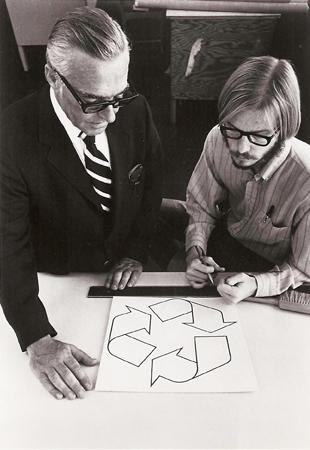Cereplast hosts nationwide design contest

Gary Anderson, left, and an executive from the Container Corporation of America review the recycling symbol. Anderson designed the recycling symbol and was the winner of the contest in 1970. Anderson is a judge for the Cereplast contest. The other man is an executive from Container Corporation of America who launched the 1970 contest.
February 15, 2011
Cereplast, a bioplastics company, is hosting a nationwide contest to design a logo that will be embossed onto bioplastic products manufactured from their pellets.
By selling the pellets to other companies that manufacture the bioplastics, Cereplast initiated the contest to create an indication that consumers are using bioplastic products.
“There’s definitely a demand with the companies that we work with that want a way to indicate the materials they are using are bioplastics,” said Nicole Cardi, vice president of communications and marketing for Cereplast.
“When [other companies] take a step to work with the materials like ours, one of the parts that’s missing right now is a way for those companies to communicate throughout their consumers that they’ve made the choice [for bioplastics].”
Cereplast will be accepting designs until March 4. Voting for the logo will remain open until March 11. Applicants must be 18 or older and a legal resident of the United States to apply.
The winner of the contest shall receive $25,000 with international recognition for the winning logo. That recognition is essential to students like John Thorson, webmaster for the Design Council.
“It’s that international recognition that employers will see right away that really would benefit what [students] are doing,” he said.
We wanted to get the public involved by encouraging public voting and also using the contest as a way to spread awareness about bioplastics, Cardi said.
Contests such as these tend to be really good for design students, said Brandon Alvarado, president of the Graphic Design Student Association.
“For design students, this is a really good opportunity to meet the goals of what other companies are looking for,” Alvarado said.
Bioplastics are produced from the proteins of plants, or various starches such as corn or tapioca. One way manufacturers might find bioplastics as an advantage is in their potential uses.
“You’re seeing [bioplastics in] a lot of food packaging applications,” said David Grewell, associate professor of agricultural and biosystems engineering.
Bioplastics have been used to make the SunChip bags, utensils and food containers. The bioplastics made from plant proteins can be used in pots for plants — which are water stable — they retain water so people don’t have to water plants over and over again, he said.
“The plant protein plastics are a source of nitrogen and serve as an additional fertilizer for the plant,” Grewell said.
Because petroleum is becoming more scarce, Grewell stresses our future dependence on renewable materials such as bioplastics.
With this in mind, Cereplast urges contestants to create a logo similar in fashion as how the recycle logo appears on products, simple yet effective.
“Usually you want a mark to be simple,” said Lisa Fontaine, associate professor of graphic design. “The simpler they are, the easier they are to remember, but simple can mean generic and you don’t want to be generic. The goal is to be a simple-looking form but still have complexity in the concept.”
A great symbol has this amazing balance between being simple enough but being unique enough so that when a person sees it, they can remember what company it stands for, Fontaine said.
“Brand recognition is something that graphic designers are always looking at,” Thorson said.
“Consumers come in and mostly they buy what they know, and if you make a logo that’s easily identifiable, people will be able to relate that to the product.”
Once a logo is selected, Cereplast will use the logo to label their pellets, the same logo will be used by other manufacturers who purchase the Cereplast’s pellets.






